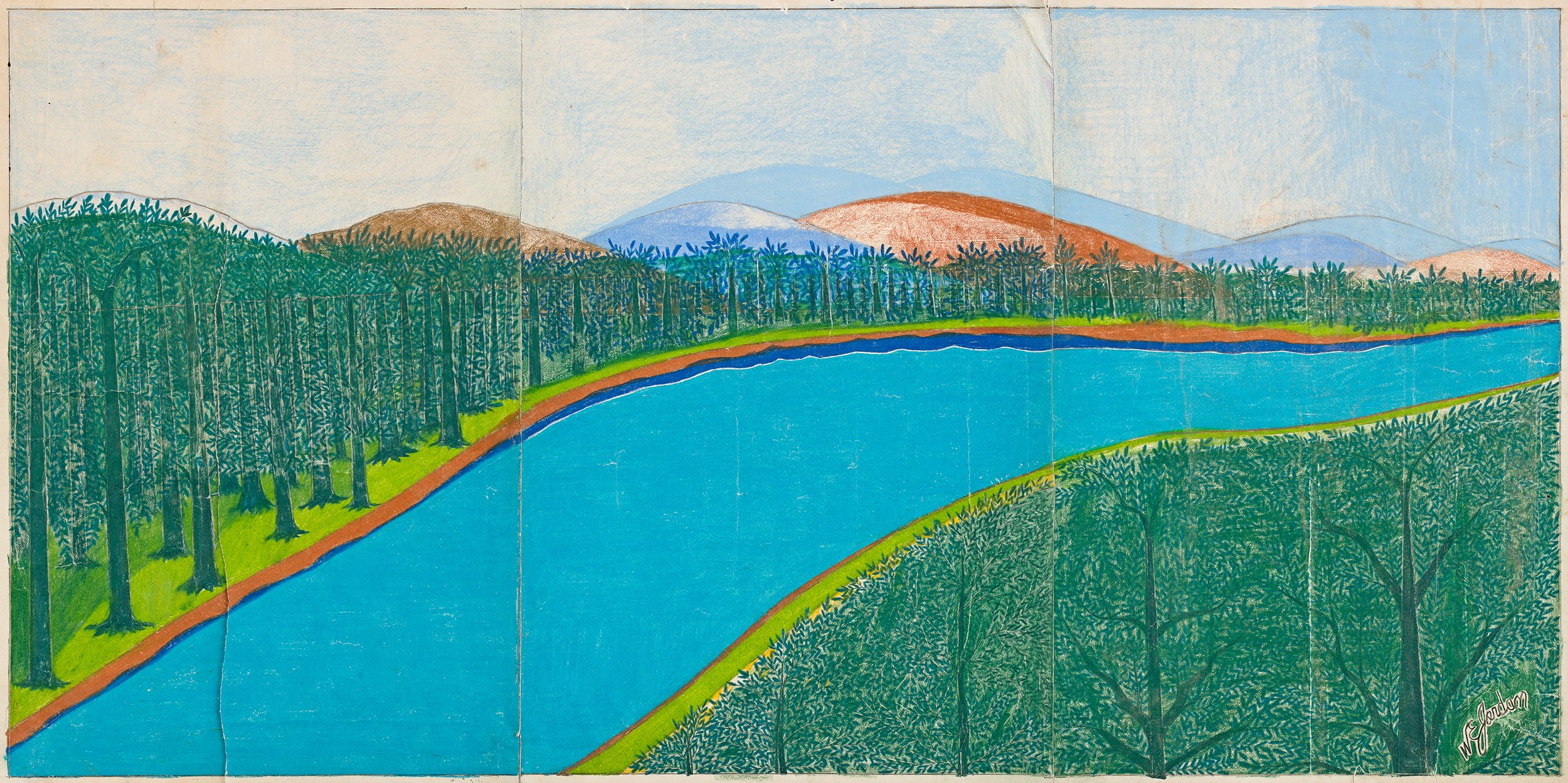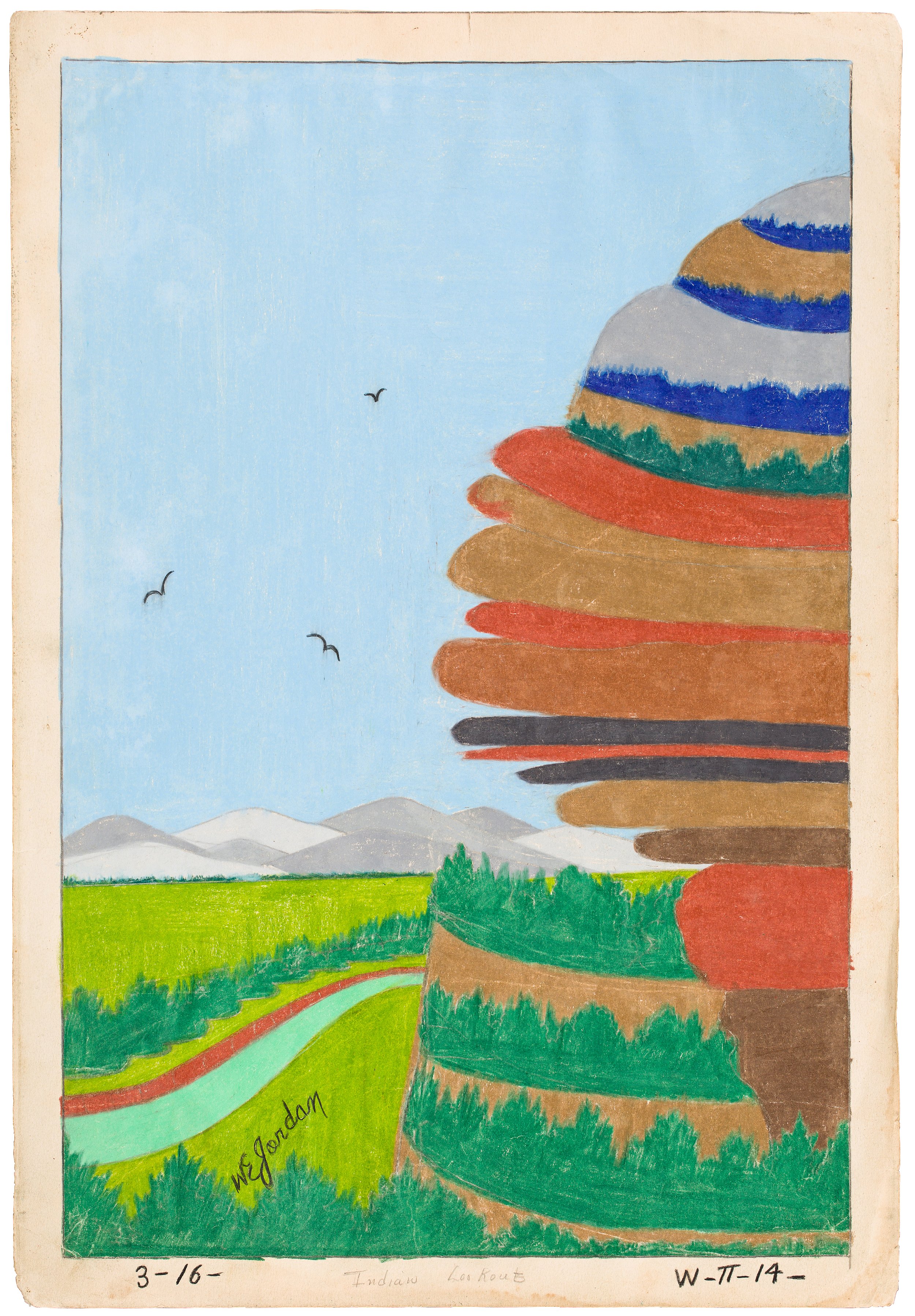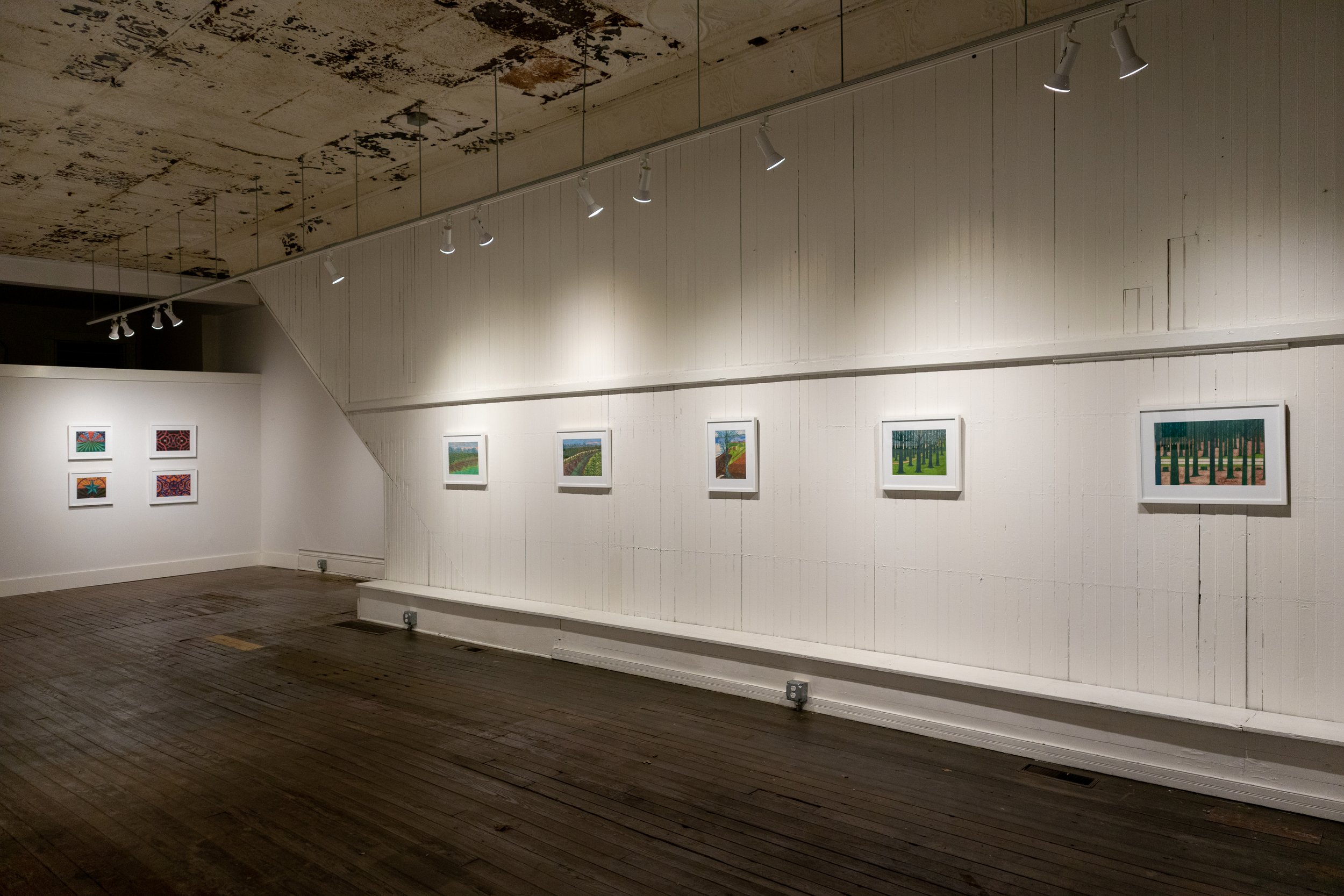
Exhibitions: Captain William E. Jordan
Captain William E. Jordan
He Paints in the Dark
January 20 - March 18, 2023

Captain William E. Jordan, Untitled, n.d., colored pencil and graphite on paper, 17.5 x 34 inches.
Captain William E. Jordan: He Paints in the Dark
January 20 - March 18, 2023
“BLIND MAN DOES BRILLIANT PASTELS.”
“HE PAINTS PICTURES HE CANNOT SEE.”
“BLIND ARTIST EXHIBITS WORKS AT MUSEUM.”
“HE PAINTS IN THE DARK.”
So exclaimed the headlines of the Savannah Morning News, The Charleston Constitution, and other publications, filled with awe and disbelief, by the rich, arresting artwork of one Captain William Jordan. The late-1950s equivalent of clickbait, these headlines evoked obvious questions: how could a blind person create images to be seen when he himself would never see them, how did he orient himself on the page, or know which color was which? After seeing Jordan’s artwork, either in print or in person, some viewers dismissed him as a fraud. Many found it hard to believe that a blind person could create the elaborate landscapes and kaleidoscopic graphics of Jordan’s colorful works, but as someone a very long time ago once said: “we walk by faith, not by sight.”
If Jordan’s artistic abilities seemed unlikely, the rest of his life story is almost equally far-fetched. Born in Chattanooga and raised in Savannah, he ran away to the circus at the age of nine, eventually landing in Philadelphia. He would go on to study medicine, serve in World War I in France, and explore much of the United States. After losing his sight at the age of 62, Jordan began making art for the first time. The scenes began in his imagination, memories hidden in his subconscious that he articulated onto paper. From this internal vision, he made outlines with heavy pencil, feeling the grooves of his marks with one hand while coloring sections with the other. His wife, Helen, arranged his pastels and pencils in a coded order, allowing the artist to match the colors he envisioned. Jordan drew from memory, depicting lush Savannah swamps, rippling western canyons, Pennsylvania farmland, and deep, dense forests. He also made drawings of abstract experiences, depicting the sensation of having glaucoma and visions from his mind’s eye. This practice became a way to “rescue from oblivion” the beauty of things he had once seen.
Jordan’s scenes are suffused with ornate foliage, precisely arranged trees and structures, long sunsets traveling along the horizon. His marks are confident and precise, yielding flat yet expansive compositions that experiment with dramatic symmetry: a perfectly balanced stone in an Arizona canyon, a boiling volcano, an endless, sweeping valley. Hypnotic, geometric designs allude to circus tents and mysterious dreams. Other memories abandon uniformity for sensitive specificity. In one drawing, a tree overtaken by wildfire stands beside a river, hungry flames reflected in the rushing current. In another, flowing hills reveal a constellation of tree stumps, the ruin of what once was a dense forest. There is often a sense of before and after, here and there, tension. Jordan’s work measures the impact of fleeting moments, a testament to the force of experiences that linger in one’s mind long after they’ve passed.
–Maria Owen

Captain William E. Jordan, Untitled, 1962, colored pencil and graphite on paper, 11 x 13 inches.

Captain William E. Jordan, Untitled, n.d., 13.5 x 11 inches.

Captain William E. Jordan, Untitled, n.d., colored pencil and graphite on paper, 11.5 x 17 inches.

Captain William E. Jordan, Crystal Lake, n.d., colored pencil and graphite on paper, 12 x 17.5 inches.

Captain William E. Jordan, Vanishing Timber, 1959, colored pencil and graphite on paper, 17.5 x 12 inches.

Captain William E. Jordan, Upstate Drive, 1961, colored pencil and graphite on paper, 12 x 17.5 inches.

Captain William E. Jordan, Untitled, n.d., colored pencil and graphite on paper, 17.5 x 12 inches.

Captain William E. Jordan, Indian Lookout, n.d., colored pencil and graphite on paper, 17.5 x 12 inches.

Captain William E. Jordan, Spring Fantasy, 1961, colored pencil and graphite on paper, 12 x 17.5 inches.

Captain William E. Jordan, Upheaval, n.d., colored pencil and graphite on paper.

Captain William E. Jordan Untitled, n.d. colored pencil and graphite on paper, 17 1/2 x 12 inches.

Captain William E. Jordan, Volcanic Magic , 1961, colored pencil and graphite on paper.

Captain William E. Jordan, Untitled, n.d., colored pencil and graphite on paper, 12 x 17.5 inches.
Biography
Born William Edward Jordan in Chattanooga, Tennessee in the mid-1890s, he was left on the steps of a church. At age nine, after the death of his adopted parents, Jordan ran away to join the circus. It was there he met a young performer who delivered him to her own family in Philadelphia, where he would finish high school and begin his studies Jefferson Medical College. As World War I commenced, Jordan was posted to the Argonne Forest in France and his education put on hold. After long months on the battlefield and in the hospital, he returned to the United States with glaucoma, a variety of silver plates and screws, and a newfound distaste for the medical profession.
Thus began Jordan’s time as “a primeval hitchhiker,” a chapter of his life where he traveled the nation, living minimally and in nature, and made a living by reporting road conditions for a national highway magazine. This adventure eventually led him to Florida, where while working in a hotel, he met Helen, a young guest who would soon (somewhat spontaneously) become his wife. While on vacation in October 1957 at the age of 62, Jordan’s sight as he knew it left him. Devastated and discouraged from adjusting to this new way of being, he returned to his native Savannah to wait for the end.
Most of the articles praising Captain William Jordan refer to his young and beautiful wife as a source of encouragement and studio helper. In reality, Helen Jordan (b. Helen Josephine Ernalovich) possessed not only a positive attitude, but extraordinary strength. After surviving a devastating childhood accident that took her brother’s life, Helen spent twelve years in casts, braces, and a wheelchair. Never expected to recover, she persevered, eventually running away from home (like her future husband) and finding her way to the Florida hotel of Jordan’s employ. When, as Jordan put it, his “lights went out,” it was Helen who persistently encouraged him to make drawings. Though he was at first infuriated by the seemingly pointless exercise, Jordan eventually put pencil to paper. Encouraged by Helen and friends, simple sketches soon became elaborate artworks.
Helen began selling the drawings door-to-door, and Jordan’s work quickly garnered the attention of a variety of clients and ultimately, museums. Though extremely precise with his compositions and palettes, errors occasionally occurred, once resulting in a landscape with a green sky. Despite its unrealistic appearance, Jordan sold it to a woman who “would have no other.” Another client was a blind French composer visiting Savannah for a concert. Though neither the composer nor Jordan could see the drawing in question, they connected on the sensation of the marks and their shared creativity. In 1959, the Georgia Museum of Art in Athens opened Jordan’s premiere exhibition, which would later travel to the Telfair Academy of Arts and Sciences. His drawings hung alongside a loan from the Metropolitan Museum of Art, including paintings by Velasquez, Renoir, and Reynolds.
Jordan eventually opened a studio at 107 West Liberty Street in Savannah, where he shared his methods with others seeking self-expression. Described by those who met him as “smiling” and “full of spirit,” Jordan sought to improve the prospects of others through teaching and donations to civic organizations throughout his life. Because of his service and efforts on behalf of disabled veterans, he was appointed a member of the Military Order of the Purple Heart and a national intelligence officer of the 1932 Bonus Expeditionary Forces. It was not only his artistic success that defied expectation; Jordan’s journey from the steps of a Savannah church to the circus, medical school, the forests and battlefields of France, the wilds of America, and finally, his Savannah studio is undeniably extraordinary. And then, there are the drawings.

Installation view, photo by Josh Porter

Installation view, photo by Josh Porter

Installation view, photo by Josh Porter

Installation view, photo by Josh Porter

Installation view, photo by Josh Porter

Installation view, photo by Josh Porter

Installation view, photo by Josh Porter

